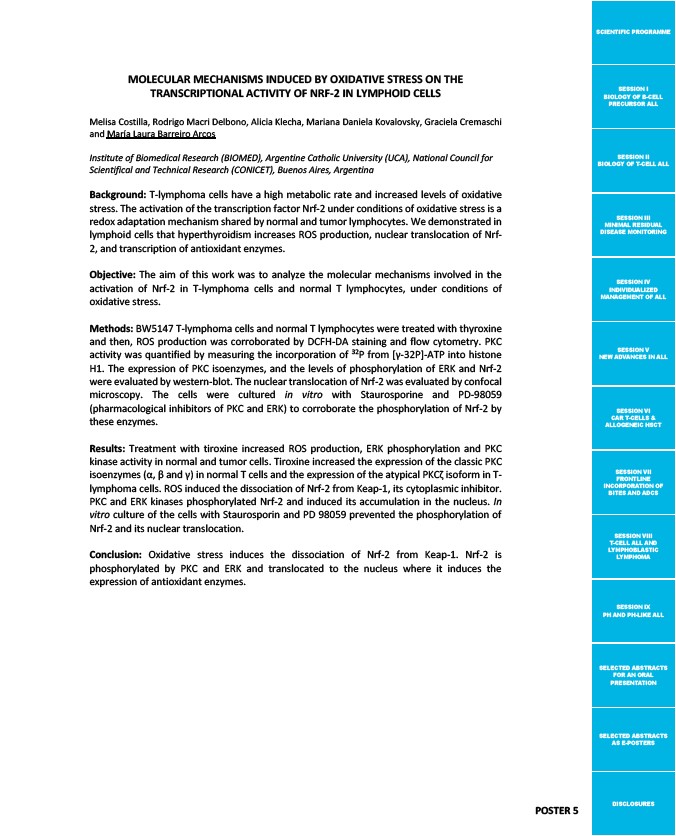
SCIENTIFIC PROGRAMME
SESSION I
BIOLOGY OF B-CELL
PRECURSOR ALL
SESSION II
BIOLOGY OF T-CELL ALL
SESSION III
MINIMAL RESIDUAL
DISEASE MONITORING
SESSION IV
INDIVIDUALIZED
MANAGEMENT OF ALL
SESSION V
NEW ADVANCES IN ALL
SESSION VI
CAR T-CELLS &
ALLOGENEIC HSCT
SESSION VII
FRONTLINE
INCORPORATION OF
BITES AND ADCS
SESSION VIII
T-CELL ALL AND
LYMPHOBLASTIC
LYMPHOMA
SESSION IX
PH AND PH-LIKE ALL
SELECTED ABSTRACTS
FOR AN ORAL
PRESENTATION
SELECTED ABSTRACTS
AS E-POSTERS
DISCLOSURES
MOLECULAR MECHANISMS INDUCED BY OXIDATIVE STRESS ON THE
TRANSCRIPTIONAL ACTIVITY OF NRF-2 IN LYMPHOID CELLS
Melisa Costilla, Rodrigo Macri Delbono, Alicia Klecha, Mariana Daniela Kovalovsky, Graciela Cremaschi
and María Laura Barreiro Arcos
Institute of Biomedical Research (BIOMED), Argentine Catholic University (UCA), National Council for
Scientifical and Technical Research (CONICET), Buenos Aires, Argentina
Background: T-lymphoma cells have a high metabolic rate and increased levels of oxidative
stress. The activation of the transcription factor Nrf-2 under conditions of oxidative stress is a
redox adaptation mechanism shared by normal and tumor lymphocytes. We demonstrated in
lymphoid cells that hyperthyroidism increases ROS production, nuclear translocation of Nrf-
2, and transcription of antioxidant enzymes.
Objective: The aim of this work was to analyze the molecular mechanisms involved in the
activation of Nrf-2 i n T -lymphoma cells and normal T lymphocytes, under conditions of
oxidative stress.
Methods: BW5147 T-lymphoma cells and normal T lymphocytes were treated with thyroxine
and then, ROS production was corroborated by DCFH-DA staining and flow cytometry. PKC
activity was quantified by measuring the incorporation of 32P from γ-32P-ATP into histone
H1. The expression of PKC isoenzymes, and the levels of phosphorylation of ERK and Nrf-2
were evaluated by western-blot. The nuclear translocation of Nrf-2 was evaluated by confocal
microscopy. The cells were cultured in vitro with Staurosporine and PD-98059
(pharmacological inhibitors of PKC and ERK) to corroborate the phosphorylation of Nrf-2 by
these enzymes.
Results: Treatment with tiroxine increased ROS production, ERK phosphorylation and PKC
kinase activity in normal and tumor cells. Tiroxine increased the expression of the classic PKC
isoenzymes (α, β and γ) in normal T cells and the expression of the atypical PKCζ isoform in T-lymphoma
cells. ROS induced the dissociation of Nrf-2 from Keap-1, its cytoplasmic inhibitor.
PKC and ERK kinases phosphorylated Nrf-2 and induced its accumulation in the nucleus. In
vitro culture of the cells with Staurosporin and PD 98059 prevented the phosphorylation of
Nrf-2 and its nuclear translocation.
Conclusion: Oxidative stress induces the dissociation of Nrf-2 from Keap-1. Nrf-2 is
phosphorylated by PKC and ERK and translocated to the nucleus where it induces the
expression of antioxidant enzymes.
POSTER 5